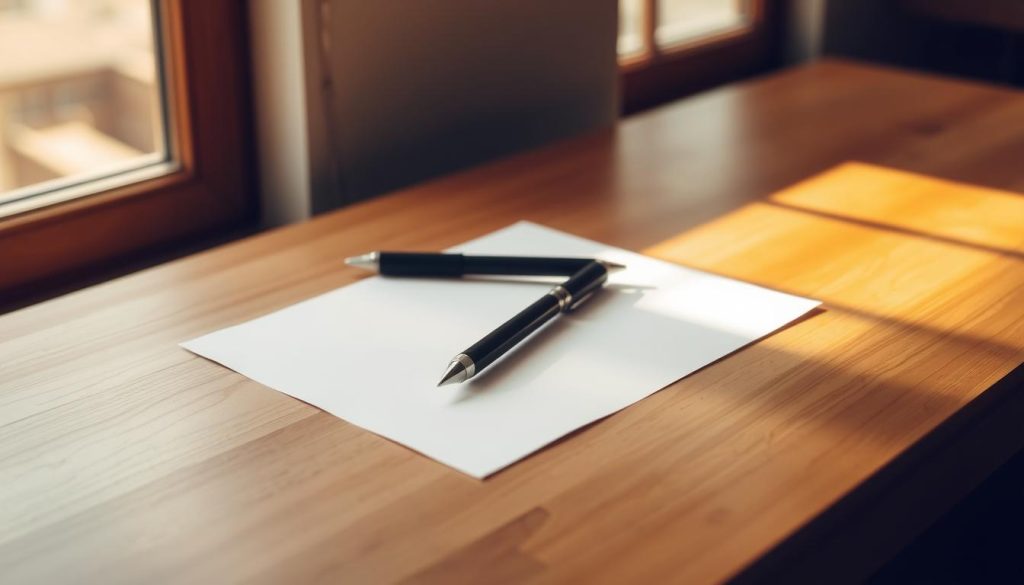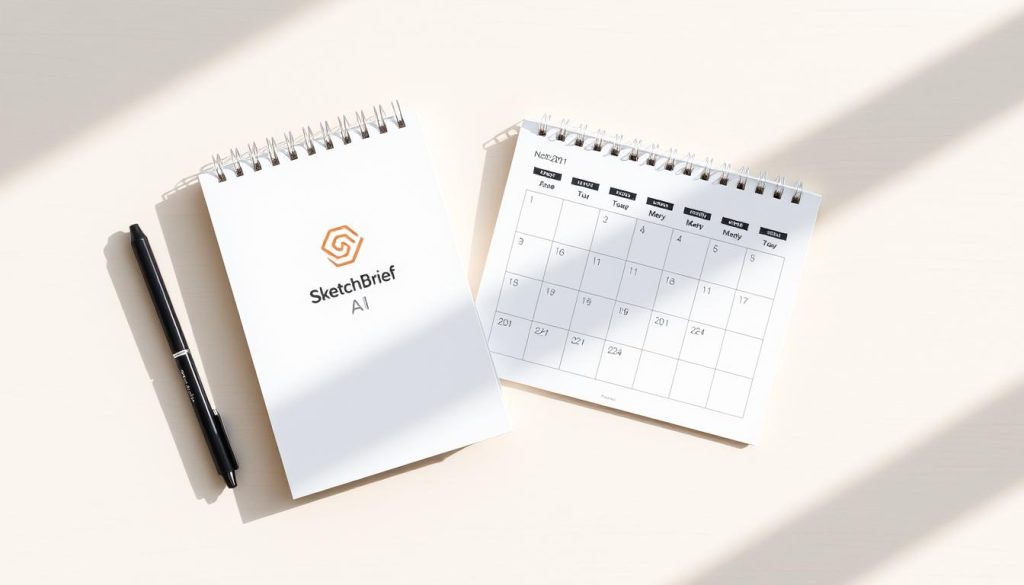Can a simple pen and a single digital tool change the way you plan your day? We explore a practical hybrid approach that blends the focus of handwriting with the speed of software. Start small: a paper brain dump clears mental clutter and primes your ideas for action.
From there, we move into a short digital review to assign tasks, set dates, and create one clear system as your source of truth. This keeps collaboration, search, and automation in one place while protecting your attention when you need to think with a pen.
We show where paper wins—ideation, prioritization, and short lists—and where digital tools keep projects moving. The goal is a simple, repeatable way to turn raw notes into deliverables without adding friction to your life.
Key Takeaways
- Start with paper to capture ideas quickly and improve focus.
- Use a short digital pass to centralize tasks and avoid duplication.
- Keep one tool as your source of truth for task tracking.
- Balance reflection with operational steps to protect your day.
- Digitize notes simply—photos preserve context without extra typing.
- Progress beats perfection; adapt the system to your team and room for work.
Why a Hybrid Beats Either-Or for Productivity Today
A hybrid approach pairs the memory boost of writing with the reach and automation of modern apps.
The cognitive edge: Writing by hand activates parts of the brain tied to memory and comprehension. Studies from 2021 and 2024 show stronger neural activity and better information retention when people take notes by hand. That makes paper ideal for ideas, meeting notes, and short lists.
Where digital tools win: Platforms like ClickUp, Asana, and Trello scale work with searchable records, delegation, and automated reminders. Slack and Airtable keep team information flowing and reduce manual handoffs. Use digital tools for shared calendars, audit trails, and task visibility.
Present-day risks: Going all-digital invites distraction—tab-switching, notification fatigue, and endless app hopping. Turn off nonessential alerts, keep your phone away during deep focus, and choose one app as the hub for task management.
- Draft and refine on paper; move only actionable items to your app.
- Limit apps by role—core management in one place, support tools sparingly.
- Use simple rules to translate notes into assigned tasks.
“Handwriting improves retention and focus while digital systems scale coordination.”
Analog First Thinking: Set Up Your Low-Distraction Core
Begin with ink: a short session on pen and paper that clears your head and points the day.
Pen-and-paper essentials for brain dumps, ideas, and notes
Keep a reliable notebook and one favorite pen. A five-minute brain dump lets you empty concerns and capture quick notes by hand.
Daily top-tasks on paper to anchor priorities
Write three meaningful tasks each morning. Protect those priorities before opening any app. Crossing items off by hand feels satisfying and keeps your system focused.
Journaling rhythms: morning pages, weekly reviews, and a “spell book”
Try Morning Pages—three pages by hand for 15–30 minutes—to clear anxiety and sharpen the brain. Do a weekly journal with 2–4 printed photos and a one-page summary to track your week and goals.

Treat a monthly “Spell Book” as playful intention-setting for longer-term goals. Capture ideas on paper first, then promote only essentials to your digital tools. This keeps both worlds clean and your life simpler.
| Practice | Time | Outcome |
|---|---|---|
| Brain dump | 5 minutes | Clear head, surface tasks |
| Morning Pages | 15–30 minutes | Reduce anxiety, spark ideas |
| Daily top three | 2 minutes | Anchor priorities for the day |
| Weekly review | 20–30 minutes | Record progress with photos |
Digital for Execution: Build a Simple, Centralized System
Make one app the home for every active task, so decisions and deadlines live in one place. This keeps task management clean and reduces duplicate work.
Pick a single app as your source of truth—ClickUp for teams or Todoist for solo work. Standardize fields, statuses, and views so everyone understands the plan and the process.
Choose your source-of-truth app
- Pick one hub for live due dates and ownership; treat it as the only place for updates.
- Use tools like ClickUp, Asana, or Todoist as the core; limit extra apps.
- Connect Slack and Google Docs or Notion for shared notes and decisions.
Projects, collaboration, and calendars that scale
Map projects with clear scopes, owners, and timelines. Store SOPs and recurring checklists in the system so execution stays consistent week to week.
What belongs digital by default
- Keep contracts, invoices, and time tracking digital for security and reporting—PSOhub is an example for invoices and billable time.
- Use Airtable for structured information and project metadata.
- Use Google Calendar as the execution glue; block time for deep work and align across time zones.
| Category | Example | Why digital |
|---|---|---|
| Task hub | ClickUp / Todoist | Centralized updates, single source of truth |
| Collaboration | Slack + Google Docs/Notion | Fast decisions, shared notes and edits |
| Structured data | Airtable | Project metadata and reporting |
Keep tools minimal, adopt them deeply. We recommend promoting only vetted notes from your notebook into the app to prevent backlog bloat. This is a practical way to turn ideas into scheduled work and protect your life and focus.
Design Your Day: Analog, Digital, Analog Flow
We recommend a three-part daily loop that keeps thinking clear and execution reliable.

Morning: Start with a five-minute paper brain dump. Capture priorities and quick notes by hand. Then move only the must-do items into time blocks on your calendar.
Mid-day digital check
At mid-day, open your task app to review status and incoming requests. Re-plan the afternoon based on real constraints and team needs.
Afternoon analog refinements
After lunch, rewrite your top three for the rest of the day on paper. Keep a small hand-written list by your keyboard—it’s the first place you look when context switches appear.
Keep the process tight: paper helps thinking; apps help execution; the calendar guarantees the time exists.
| Step | Action | Why it works |
|---|---|---|
| Morning paper | 5-minute brain dump + pick top 3 | Clears mind and creates a focused plan for the day |
| Mid-day app review | Check ClickUp or similar; adjust due dates | Aligns team signals and real deadlines |
| Afternoon paper | Refine list, photo backup | Preserves context and keeps you anchored until close of day |
- Capture call notes by hand; move only decisions and action items to the system.
- Use a weekly checkpoint—same day, same hour—to sync lists with your digital plan for the coming week.
- Take a quick photo of your list before you leave your desk for a mobile reference without opening extra tools.
How to Connect Paper and Apps Without Duplication
Make a simple rule: capture once, route once, and review on a short cadence. This keeps your ideas readable and prevents fragmented information across systems.
Capture once, decide where it lives, and review on a cadence
When you write, decide immediately if the item needs tracking or is just a thought.
- Capture ideas once—in your notebook or directly in the app—to avoid duplicate entries.
- Use your phone to photograph hand-written pages for archive and quick reference.
- Only move actionable tasks into your task hub; leave reflective notes on paper.
- Batch short reviews—daily and weekly—to transfer essential items and free up headspace.
Fast digitizing: photos, voice-to-text, and structured transfers
Use quick methods that preserve context without retyping every line.
- Snap photos for visual context; tag images in your app so details are findable later.
- Lean on voice-to-text when you’re away—funnel those notes into a single inbox for processing.
- Adopt a transfer template: title, owner, due date, and next step to keep management clean.
- Pick one tool as the authoritative hub—use tools like ClickUp or Todoist and tag items coming from paper.
| Method | When to use | Expected result |
|---|---|---|
| Photo of page | After a brain dump or meeting | Preserves context without retyping |
| Voice-to-text | On the move or quick capture | Fast capture to a processing inbox |
| Structured transfer | Daily or weekly review | Tasks enter management ready for action |
| Tagging in app | When importing from paper | Easy audit of paper→digital conversion |
Keep one app as your source of truth and protect your time by batching transfers. We find this balance lets thinking stay on paper while execution lives where teams can act—improving overall productivity without extra duplication.
Analog Workflow Productivity in Action
Here’s how simple routines move ideas from a page to a published outcome.
Solo creator: pen-first ideation, app-based publishing pipeline
Start with a short paper brainstorm to shape your concept in minutes. Write a one-page outline in your journal, then add the outline to ClickUp or Notion as a publishing project.
Turn outline items into three concrete tasks with due dates, assets, and a single owner. This keeps creative space in your journal and execution in the app.
Team projects: handwritten meeting notes → task tickets and SOPs
Capture meeting points by hand to stay present. After the meeting, promote only decisions, risks, and actions into Asana or ClickUp as tickets.
Store SOPs in Google Docs or Notion so onboarding and handoffs don’t rely on one person’s memory.
Life admin: family wall calendar meets shared Google Calendar
Keep a visible wall calendar at home for shared visibility. Mirror important entries in a shared Google calendar so reminders and conflicts sync across devices.
Use PSOhub for invoices and time tracking; connect Slack and Airtable to align distributed people without duplicating info.
| Use case | Primary place | Key output |
|---|---|---|
| Solo publishing | Paper → ClickUp/Notion | Outline → 3 tasks, due dates |
| Team projects | Notebook → Asana/ClickUp + Docs | Tickets + SOPs |
| Household admin | Wall calendar → Google Calendar | Shared events + reminders |
- Use the two-minute rule during reviews: if a small task takes minutes, do it now.
- Keep a one-page bridge in your notebook listing the next three actions for each project.
- Close the loop weekly to reconcile notes and app status before the next week.
Avoiding Pitfalls and Measuring What Matters
Distractions creep in when we let too many apps claim our attention. Set boundaries so your core management stays crisp and reliable.
Reduce tool sprawl, resist notification traps, and set boundaries
Cut noise, keep what matters
Audit apps quarterly and consolidate overlapping functions into one hub. Use focus modes and controlled alerts so your productivity system supports deep work.
Keep essential items digital—contracts, invoices, and time tracking—so information is secure and findable. Preserve room for analog thinking; five minutes with a pen can restore clarity faster than another dashboard.
Weekly reflection to refine lists, projects, and goals
Run a short weekly review to prune lists and confirm goals. Track leading indicators: time blocked vs. time executed, tasks completed by priority, and project health.
- Standardize intake and estimation so tasks are right-sized and predictable.
- Apply lightweight management rituals—daily check-ins, weekly prioritization, and monthly capacity reviews for people and projects.
- Close feedback loops quickly: if your app backlog surges, adjust rules immediately.
| Metric | Why it matters | Target |
|---|---|---|
| Time blocked vs. executed | Shows how scheduled time becomes real | ≥ 80% |
| Tasks by priority completed | Measures focus on high-impact work | Top 3 daily done |
| Project health score | Flags risks early across projects | Green/Yellow/Red |
“Measure outcomes over outputs; let tasks roll up to meaningful goals.”
Conclusion
In closing, adopt a small routine that moves ideas from your journal into action.,
A balanced hybrid is the clear way to the end: use pen and paper to think, then a single app to execute and track each task. Keep essential records digital—contracts, invoices, and time—so audits and sharing stay simple.
Let journaling ground decisions. Do morning pages and a weekly review to prune, promote, and prioritize. Reserve pen and paper for daily focus and short lists; use minimal tools for coordination.
Try this approach for two weeks. Measure what matters, adjust as life changes, and you’ll find the best way to sustain long-term productivity without burnout at the end.

Leave a Reply